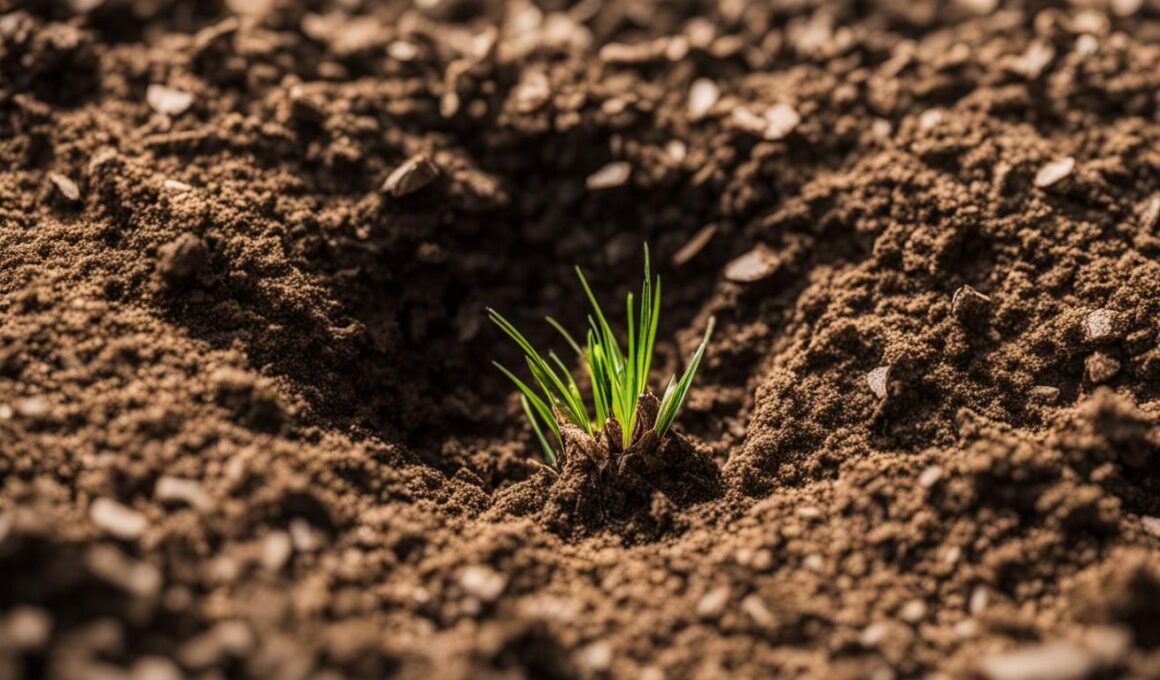Welcome to our comprehensive guide on grass seed lifespan, storage, and dormancy. If you’ve ever wondered how long your grass seed can remain viable or if it can go bad, you’re in the right place. We’ll address these questions and more, providing you with the knowledge to ensure your lawn thrives.
Have you ever stored grass seed for future use, only to wonder if it’s still good? Grass seed can typically last anywhere from two to 10 years, but its viability decreases over time. In fact, the germination rate decreases by approximately 10 percent each year. So, it’s important to know how to properly store your grass seed to maximize its lifespan and ensure successful germination.
Proper storage conditions are key to keeping your grass seed fresh. Store the seeds in a dark, cool, and humidity-free space. Excess moisture, humidity, and direct sunlight can all negatively impact seed viability. To prolong the lifespan of your grass seed, consider storing it in sealed containers or bulk storage bags to protect it from moisture and pests, such as rodents.
Apart from storage, other factors can affect the lifespan of grass seed. Production location, harvesting conditions, and seed quality before packaging all play a role in the seed’s viability. Therefore, it’s essential to choose high-quality grass seed from reputable sources to maximize its germination potential.
Stay tuned as we explore the fascinating world of grass seed dormancy, survival without water, and the importance of proper watering techniques for optimal germination rates. With the right knowledge and care, you can achieve a healthy, lush lawn that will be the envy of the neighborhood.
Can Grass Seed Survive Dormancy?
Grass seeds have the ability to withstand dormancy during the winter season, particularly when planted in late fall or early winter. This practice, known as dormant seeding, involves carefully preparing the soil and raking the seed into the ground before the area becomes covered in snow. Dormant seeding offers several benefits, including saving time in the spring by taking advantage of the winter season for seed distribution and preparation.
However, it is important to note the risks associated with dormant seeding. If the weather unexpectedly warms up during the winter, the seeds may sprout prematurely and be unable to survive the subsequent frost. To mitigate these risks and increase the chances of successful dormant seeding, proper soil preparation, careful timing, and the selection of the appropriate grass seed variety for your region are crucial.
Factors Affecting Grass Seed Lifespan Without Water
The lifespan of grass seed without water is influenced by several key factors, including soil type and conditions, climate, and the type of grass seed used. These factors play a crucial role in determining how long grass seed can survive without water and maintain its viability.
Soil Type and Conditions: The type of soil and its drainage properties directly impact the need for watering grass seed. Well-draining soils require more frequent watering to keep the seeds hydrated. Sandy soils tend to lose moisture quickly, demanding more frequent watering, while clay soils retain moisture for longer periods, reducing the need for frequent irrigation.
Climate: Climate and weather patterns also affect the grass seed’s lifespan without water. Hot and dry conditions accelerate soil moisture evaporation, increasing the requirement for watering. In such climates, grass seed may require more frequent watering to stay hydrated and maintain its viability for an extended period.
Type of Grass Seed: Different types of grass seeds exhibit varying levels of drought resistance. Some varieties are naturally more tolerant of dry conditions and can survive longer without regular watering. When selecting grass seed for your lawn, consider choosing drought-resistant varieties to improve the grass seed’s ability to withstand periods without water.
Understanding these factors and their impact on grass seed lifespan without water is essential for maintaining a healthy and vibrant lawn. By selecting the appropriate grass seed variety, considering the soil type and conditions, and factoring in the local climate, you can optimize the grass seed’s ability to survive without watering and ensure its long-term viability.
Importance of Water for Grass Seed
Water is essential for the successful germination and growth of grass seed. It plays a crucial role in activating enzymes that break down the seed coat, allowing the seed to absorb nutrients and initiate the germination process. Additionally, water helps maintain the required soil moisture levels, creating an ideal environment for healthy root development and optimal germination rates.
Consistent soil moisture is vital for promoting the establishment of healthy root systems. When the soil is properly hydrated, roots can penetrate deeper, providing stability and absorbing essential nutrients from the soil. This, in turn, contributes to the overall health and resilience of the grass.
Proper watering techniques are key to ensuring successful grass seed growth. During the germination period, it is important to provide sufficient water to keep the soil consistently moist, as dry conditions can hinder germination. However, caution must be exercised to avoid overwatering, which can lead to shallow root growth and increase the risk of disease and weed infestation.
Deep watering is highly recommended once the grass has established itself. This allows the water to penetrate the soil deeply, encouraging the roots to grow deeper as well. Deeper root systems have better access to water and nutrients, making the grass more resilient in times of drought and stress.
By understanding the importance of water for grass seed germination and employing proper watering techniques, you can promote the development of healthy root systems and maximize the success of your grass seeding efforts.
Does the Lifespan of Grass Seed Affect the Best Time to Plant in Seattle?
When considering the best time to plant grass in Seattle, it is important to take into account the lifespan of the grass seed. Some types of grass seed may have a shorter lifespan and should be planted during the optimal growing season to ensure successful germination and establishment.
Conclusion
Proper storage is crucial for maximizing the lifespan of grass seed. Taking into account factors such as seed quality and storage conditions can significantly impact the viability of your grass seeds. When stored in sealed containers or bulk storage bags in a dark, cool, and humidity-free environment, grass seeds can maintain their germination potential for several years.
Dormant seeding during winter can be an effective way to establish a lush lawn in spring. However, it’s important to be aware of the risks involved. Sudden warm spells can cause the seeds to sprout prematurely, leading to potential damage from frost. Careful planning and timing, along with proper soil preparation, are critical for successful dormant seeding.
The lifespan of grass seed without water depends on various factors such as soil type, climate, and the specific grass seed variety. Some grass seed varieties are more drought-resistant than others, with the ability to survive longer periods without watering. Understanding your soil conditions, local climate, and selecting the appropriate grass seed type can help ensure the survival of your grass seed when water is limited.
Watering is essential for the germination and growth of grass seed. Proper watering techniques, such as providing sufficient water during the germination period and deep watering to encourage root development, are vital for maximizing germination rates. Consistent soil moisture levels promote healthy root systems and overall lawn growth. By incorporating these practices, you can ensure the vitality of your lawn and achieve optimal results when planting grass seed.











